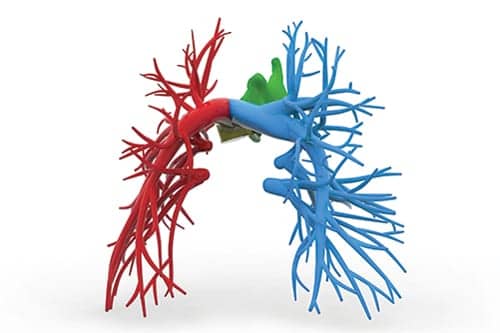For the first time in over a decade, updated guidelines for the management of adults with ventilator-associated pneumonia (VAP) and hospital-acquired pneumonia (HAP) have been issued.

Earlier this year, the American Thoracic Society (ATS) and the Infectious Disease Society of America (IDSA), in collaboration, issued an updated set of clinical practice guidelines for the management of adults with hospital-acquired pneumonia (HAP) and ventilator-associated pneumonia (VAP).
In 2005, these two organizations published “evidence-based recommendations for the prevention, diagnosis and treatment of hospital care-associated pneumonia (HCAP), HAP and VAP.”1 During the last 11 years, new studies and research has brought about better understanding of these conditions and ways in which to manage and treat them.
The goal of the new guidelines is to “provide evidence-based guidance on the most effective diagnosis and management of nonimmunocompromised patients with HAP/VAP,” according to Andre C. Kalil, MD, department of internal medicine, Division of Infectious Diseases, University of Nebraska Medical Center, lead author of the guidelines.
Furthermore, the guidelines are intended for use specifically by healthcare professionals, such as surgeons, anesthesiologists, hospitalists and specialists in infectious and pulmonary diseases, who treat hospitalized patients with nosocomial pneumonia. The ATS and IDSA anticipate that these recommendations will serve as the “basis for the development and implementation of locally adapted guidelines.”
Focused on Antibiotic Use
Previously released guidelines in 2005 addressed HCAP, which experts believed put patients at high risk for multi-drug resistance (MDR) pathogens. However, since that time evidence has shown that this is not the case. Rather, “underlying patient characteristics” play a role in determining individual risk for MDR pathogens. Moreover, HCAP occurs in outpatient settings, such as urgent care or emergency rooms for the most part. Therefore, current guidelines chose to remove references to HCAP.
In general, the new guidelines focus on diagnostic methods for VAP/HAP, treatment initiation, the role of antibiotics and different delivery systems and length of treatment. The authors agree that ongoing research is needed for all the topics and admit that high-quality evidence is lacking for many of the recommendations. According to the guidelines, strong recommendations were sometimes made on the basis of lower quality evidence when the researchers believed that most clinicians would concur with those recommendations.
The key recommendations include a shorter course of antibiotic therapy for VAP/HAP; the use of antibiograms to track hospital-specific and local bacterial trends; and appropriate treatment options based on the antibiogram results. The recommendations were designated as “strong” or “weak” (or conditional).
Melissa Miller, MD, MS, from the Agency for Healthcare Research and Quality’s (AHRQ) Center for Quality Improvement and Patient Safety, Division of Healthcare-associated Infections, reported that the new guidelines are intended to update recommendations based on recently published evidence and that they will likely help simplify the approach to and management of VAP and HAP.
Antibiograms Determine Trends
According to Miller, one of the most important changes is the recommendation to base antibiotic changes on an institution-specific antibiogram. “The antibiogram is a sum of the pattern of resistance for bacteria in the hospital. Cultures in the local area determine an aggregated trend and which antibiotics are most likely to effectively treat [bacteria],” she said. “This can vary by hospital. Typically, the hospital lab compiles an updated list. The frequency of antibiogram release depends on the volume of patients. For instance, a large hospital might be able to update the list quarterly or even monthly.”
The use of an antibiogram is a shift from previous recommendations, which focused on the use of multiple broad-spectrum drugs. “The antibiogram gives information about local resistance patterns,” Miller said. “If most of the cultures in the hospital are sensitive to narrow spectrum antibiotics, then you would be able to use narrow spectrum antibiotics. The new guidelines recommend using patient risk factors for resistant infections in combination with local antibiograms to make decisions about antibiotic coverage for VAP and HAP. This is patient-centered care.” The combination will allow more opportunities to narrow antibiotic coverage where possible.
Also, in the past sampling emphasized an invasive procedure, eg, a bronchoscopy. The new guidelines take a different approach. “The evidence reviewed by the guidelines shows the benefits [of an invasive procedure and associated tests] but doesn’t justify the risk, expense and delay involved. This can be done noninvasively. For example, the patient coughs up sputum or you can suction the patient for a sputum culture,” Miller said. “It takes less time to process in the lab and is less invasive. There’s a lower risk to the patient by avoiding an invasive procedure and there’s less delay in getting the results.”
Cutting Length of Treatment
The new guidelines reevaluated the length of treatment with antibiotics and call for cutting the course of treatment in half. “Based on the evidence, seven days is enough for a course of antibiotics for most patients,” Miller said, noting that in some cases there could be patient and infection factors that might impact the length of treatment. “You need enough to fight the infection, but traditional courses have been much longer, which can lead to more side effects from antibiotics and more resistance.”
Another major change relates to the way the recommendations are graded, Miller reported. Rather than the old classification, which was broken into complicated number and letter subsets, the new grades make either “strong” or “weak or conditional” recommendations.
While the guidelines are intended ‘to minimize patient harm and exposure to unnecessary antibiotics and reduce the development of antibiotic resistance,”1 Miller pointed out that “change in practice is difficult.” She said, “This can be particularly true in an intensive care unit, as many clinicians tend to believe their patients are sicker than others’. This is why evidence-based guidelines from professional societies are so important, as they can offer trusted guidance to clinicians to improve care for their patients.”
Kalil et al provided an important disclaimer before the executive summary of the guidelines, noting that the recommendations “…are not intended to supplant physician judgment with respect to particular patients or special clinical situations. IDSA considers adherence to these guidelines to be voluntary, with the ultimate determination regarding their application to be made by the physician in the light of each patent’s individual circumstances.” He emphasized that the ATS/IDSA guidelines do not address VAP prevention; the Society for Healthcare Epidemiology of America (SHEA) has updated VAP prevention recommendations.
Miller pointed out that AHRQ was not involved in creating the new guidelines but supports the changes. “AHRQ doesn’t directly promote the guidelines but these recommendations align with our initiatives to reduce unnecessary antibiotic use and improve care for patients,” Miller said. AHRQ’s Safety Program for Mechanically Ventilated Patients combines the Comprehensive Unit-based Safety Program (CUSP) and evidence-based recommendations to reduce complications related to mechanical ventilation, including VAP. The project is expected to wrap up in Fall 2016 and a toolkit of evidence-based, practical resources will be available gratis for others to use. AHRQ also supports investigator-initiated research to prevent healthcare-associated infections and combat antibiotic resistance.
Shift in Thinking
According to Jared Chiachiaro, MD, MS, assistant professor of medicine in the Division of Pulmonary, Allergy and Critical Care Medicine at the University of Pittsburgh, the new recommendations reflect “a shift in the way we think about treatment.” He explained that providers need to be familiar with trends at their hospitals and local antibiotic susceptibility patterns. “This is a contrast to former beliefs that one size fits all,” he said.
Chiachiaro noted that whenever any new guidelines are issued, implementation becomes a challenge. He cited the suggestion to take aspirin following a heart attack as a prime example. “It’s difficult to get one hundred percent of the people to do this, even though there’s the strongest level of evidence that this works,” he said. “This falls into implementation science, which explains how to translate guidelines into real world practice in an existing system.”
The recommendations admit that not all suggestions are based on evidence, which may negatively impact implementation, Chiachiaro noted, pointing out that not all medical fields have the same level of evidence that others do. “For example, in cardiology there is a lot of evidence because a lot of people have heart disease so you can do studies. But HAP and VAP with multi-drug origins are difficult to test in a random controlled trial. Part of the lack of evidence is not because it’s not such a prevalent problem,” he said. “The guidelines do point out areas where there is a lack of evidence or conflicting evidence. There is a balance between why these recommendations are being made and what the limitations are.”
However, the fact that the recommendations are the result of expert consensus from two well-respected organizations should bolster adherence. “People still need guidance on how to approach the problem of multi-drug resistance,” he said. “The ATS and IDSA did a nice job of stating up front that the guidelines are not meant to replace physician judgment. Hospitals should start to develop anti- sensitivity profiles to make good judgments.”
The new guidelines should prove to be of value in a couple of ways, Chiachiaro noted. “The shift initially upfront in treatment will overall decrease how much antibiotic and how long the patient will be treated with antibiotics. It will provide benefits in terms of fewer side effects and antibiotic-related complications. Choosing antibiotics wisely, giving fewer antibiotics and for a shorter time will reduce the risk of antibiotic-associated complications,” he said. “This [regimen] will help with emerging resistance and result in cost savings, which will hopefully be passed down to health care consumers. It’s a step forward in the way we think about treatment.” RT









